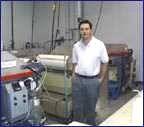
Curated with aloha by
Ted Mooney, P.E. RET

The authoritative public forum
for Metal Finishing 1989-2025

Thread 63/29
Plating density tests
Q. I am an engineer involved in mechanical equipment wear applications. Applications involve high g processing speeds in an abrasive environment. I have been conducting wear resistance tests of chrome plated steel coupons based on weight loss and the results are very erratic. After making numerous measurements, it appears the specific gravity of the plating layer is highly variable. This same test was ran with nickel plated coupons and the results were similarly disparate. Is this a known phenomenon? If so, can it be correlated to wear properties? Any insight you may have would be much appreciated. I am snatching my hair out and I don't have that much to spare.
Gary C [last name deleted for privacy by Editor]- St Louis, Missouri
2000
publicly reply to Gary C
A. I can't comment on wear resistance testing, but I have worked with "calibrated coupons" in corrosion testing. Some corrosion tests are supposed to be "calibrated" using special coupons which are weighed before and after testing. This method never has worked for us in calibrating salt spray machines, and I have heard that others have had the same experience.
This does not directly apply to your case, but it does show how things may simply not work even though it is "supposed to." Weight loss can be a variable thing.

Tim Neveau
Rochester Hills, Michigan
2000
publicly reply to Tim Neveau
A. There is a change in plating density of platinum on rectangular test tabs in the corners versus the center of the tab. In my experience, local areas of high current density plate at a different mass density than areas with a lower current density. So features play a role in the consistency of the mass density.
Susan Yip- Phoenix, Arizona
March 7, 2015
publicly reply to Susan Yip
Q, A, or Comment on THIS thread -or- Start a NEW Thread